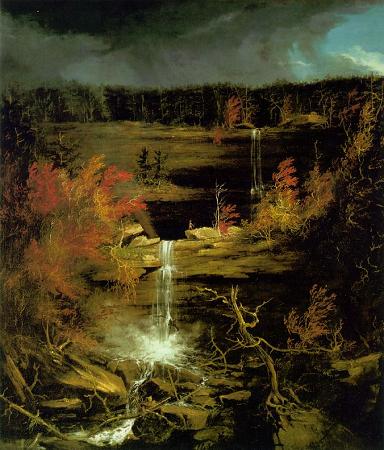Kaaterskill Falls. Kaaterskill Falls is a two-stage waterfall on Spruce Creek in the eastern Catskill Mountains of New York, between the hamlets of Haines Falls and Palenville in Greene County. The two cascades total 260 feet in height, making Kaaterskill Falls one of the highest waterfalls in New York, and one of the Eastern United States' tallest waterfalls. The waterfalls are one of America's oldest tourist attractions, being depicted or described by many books, essays, poems and paintings of the early 19th century. Long before Alexis de Tocqueville's famous essay on America, Kaaterskill Falls was lauded as a place where a traveler could see a wilder image, a sort of primeval Eden. Beginning with Thomas Cole's first visit during 1825, they became a subject for painters of the Hudson River School, setting the wilderness ideal for American landscape painting. The Falls also inspired Catterskill Falls, a poem by William Cullen Bryant. The falls, like the clove and creek with which they share a name, are a relatively recent addition to the Catskills in terms of geologic time. They evolved through stream capture at the end of the Illinoian Stage, when runoff from the glacial melt that created North-South Lake began to flow away from the nearby headwaters of Schoharie Creek and down the steep slopes of the newly created clove. The rushing waters of what would become known as Spruce Creek eroded a natural amphitheater at roughly 2,000 feet on the south slope of South Mountain. Most of the drop is accounted for by the upper cascade. The shelf dividing the two falls is the break between the Manorkill Sandstone formed in the Middle Devonian period and the Oneonta-Genesee sandstone-shale mixture of the late Devonian period. While the falls' existence was known by indigenous peoples of the Hudson Valley prior to European colonization, it had a minor role for them, who generally avoided the Catskill Mountains due to the limited agricultural possibilities of higher elevations, though they occasionally ventured into the mountains to hunt game. Thomas Cole populated the falls with an occasional Indian in his earliest paintings. The falls' name, like that of the features around it, probably came from a later corruption of the name Catskill by English-speaking colonists of the early 18th century. Cat could mean Bobcat or Mountain Lion, while kill means stream in Dutch, the main language of the first European colonists of the 17th century. Early American naturalist John Bartram and his son William visited the falls on his famous 1753 expedition to the area. He wrote about it in A Journey to Ye Cat Skill Mountains with Billy, one of the earliest Catskill travelogues, which became widely read not only in the colonies but back in Britain as well. He described it as the great gulf that swallowed all down and estimated their height at approximately a hundred feet, in a somewhat hurried account. However, he may have written his patron Peter Collinson a more detailed version, and his son William may have included a sketch. The waterfalls' fame in America really began when Washington Irving mentioned them in his story published during 1819, Rip Van Winkle. Prior to that time Americans tended to regard the mountains and valleys of upstate New York as an unsafe region populated by savage natives. The famous painting, The Murder of Jane McRea by Kingston, New York, native John Vanderlyn, best illustrates this local attitude. It wasn't until after the War of 1812 when the frontier shifted far to the west, that attitudes changed and people began to regard the lofty heights around the Hudson River valley as something scenic rather than ominous or fearsome. About the same time the profitability of local farming began to decrease due to cheap grain shipped east by an Erie Canal, usable in stages while under construction. Irving's story invited Cole and others to discover the valley when Irving introduced the Falls of the Kaaterskill in Rip Van Winkle. Irving wrote the following passage about Rip reawakening after a slumber of 20 years and walking home: At length he reached to where the ravine had opened through the cliffs to the amphitheatre; but no traces of such an opening remained. The rocks presented a high impenetrable wall, over which the torrent came tumbling in a sheet of feathery foam, and fell into a deep broad basin, black from the shadows of the surrounding forest.
more...




